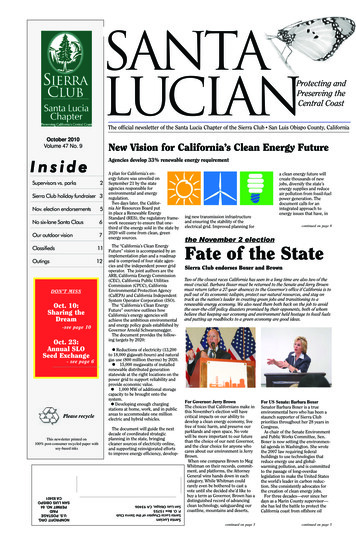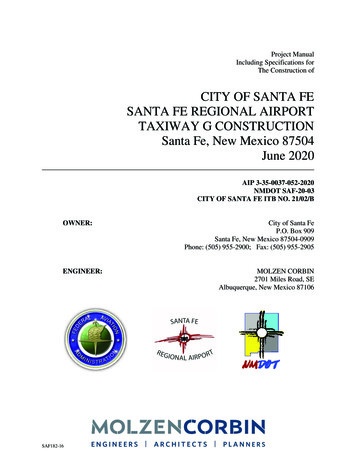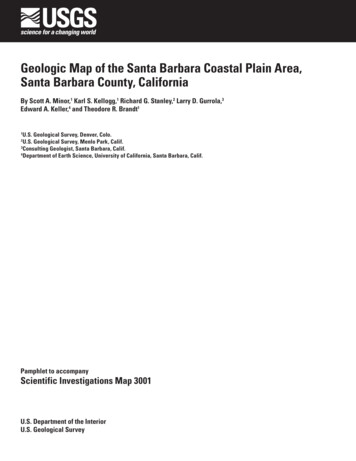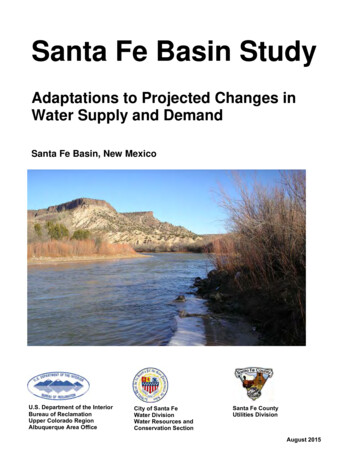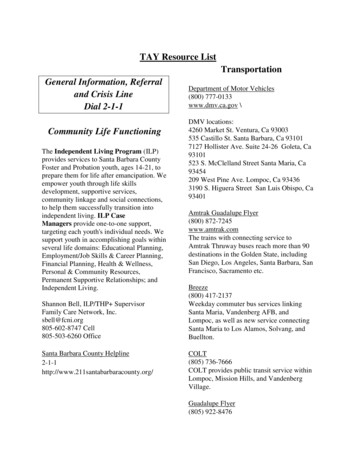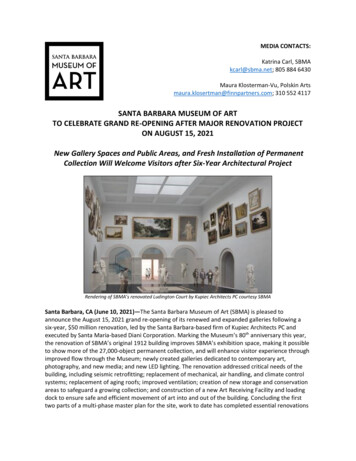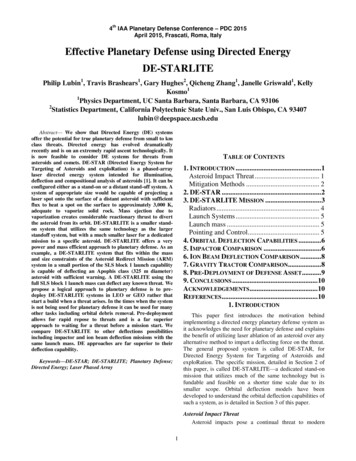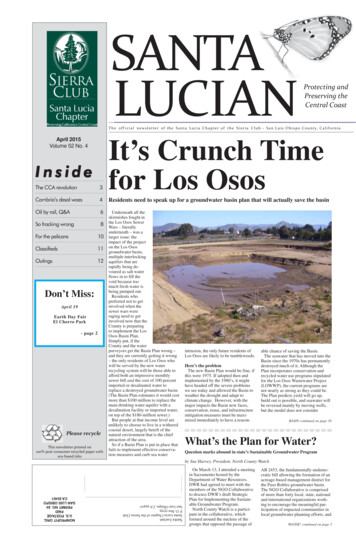
Transcription
1Santa Lucian April 2015SANTALUCIANProtecting andPreserving theCentral CoastT h e o f f i c i a l n e w s l e t t e r o f th e S a n t a L u c i a C h a p t e r o f t h e S i e r r a C l u b S a n L u i s O b i s p o C o u n t y, C a l i f o r n i aApril 2015Volume 52 No. 4InsideIt’s Crunch Timefor Los OsosThe CCA revolution3Cambria’s desal woes4Residents need to speak up for a groundwater basin plan that will actually save the basinOil by rail, Q&A6So fracking wrong8Underneath all theskirmishes fought inthe Los Osos SewerWars – literallyunderneath – was alarger issue: theimpact of the projecton the Los Ososgroundwater basin,multiple interlockingaquifers that arerapidly being devoured as salt waterflows in to fill thevoid because toomuch fresh water isbeing pumped out.Residents whopreferred not to getinvolved when thesewer wars wereraging need to getinvolved now that theCounty is preparingto implement the LosOsos Basin Plan.Simply put, if theCounty and the waterpurveyors get the Basin Plan wrong –and they are currently getting it wrong– the only residents of Los Osos whowill be served by the new waterrecycling system will be those able toafford both an impressive monthlysewer bill and the cost of 100 percentimported or desalinated water toreplace a destroyed groundwater basin.(The Basin Plan estimates it would costmore than 100 million to replace themain drinking water aquifer with adesalination facility or imported water,on top of the 180-million sewer.)But people at that income level areunlikely to choose to live in a witheredcoastal desert, largely bereft of thenatural environment that is the chiefattraction of the area.So if a Basin Plan is put in place thatfails to implement effective conservation measures and curb sea waterFor the pelicans10Classifieds11Outings12Don’t Miss:April 19Earth Day FairEl Chorro Park- page 2Please recycleThis newsletter printed on100% post-consumer recycled paper withsoy-based inksintrusion, the only future residents ofLos Osos are likely to be tumbleweeds.Here’s the problemThe new Basin Plan would be fine, ifthis were 1975. If adopted then andimplemented by the 1980’s, it mighthave headed off the severe problemswe see today and allowed the Basin toweather the drought and adapt toclimate change. However, with themajor impacts the Basin now faces,conservation, reuse, and infrastructuremitigation measures must be maximized immediately to have a reason-able chance of saving the Basin.The seawater that has moved into theBasin since the 1970s has permanentlydestroyed much of it. Although thePlan incorporates conservation andrecycled water use programs stipulatedfor the Los Osos Wastewater Project(LOWWP), the current programs arenot nearly as strong as they could be.The Plan predicts yield will go up,build out is possible, and seawater willbe reversed mainly by moving wells,but the model does not considerBASIN continued on page 10What’s the Plan for Water?Question marks abound in state’s Sustainable Groundwater Programby Sue Harvey, President, North County WatchOn March 13, I attended a meetingin Sacramento hosted by theDepartment of Water Resources.DWR had agreed to meet with themembers of the NGO Collaborativeto discuss DWR’s draft StrategicPlan for Implementing the Sustainable Groundwater Program.North County Watch is a participant in the collaborative, whichformed around the nucleus of thegroups that opposed the passage ofAB 2453, the fundamentally undemocratic bill allowing the formation of anacreage-based management district forthe Paso Robles groundwater basin.The NGO Collaborative is comprisedof more than forty local, state, nationaland international organizations working to encourage the meaningful participation of impacted communities inlocal groundwater planning efforts, andWATER? continued on page 5Santa Lucia Chapter of the Sierra ClubP. O. Box 15755San Luis Obispo, CA 93406Santa LucianNONPROFIT ORG.U.S. POSTAGEPAIDPERMIT NO. 84SAN LUIS OBISPOCA 93401
2Earth Day SLOCelebrating 25 Years2015 marks the 25th Anniversary of Earth Day in San Luis Obispo County!The Earth Day Alliance invites you to be part of this year’s San Luis ObispoCounty Earth Day Fair and Music Festival on Sunday, April 19, at El ChorroRegional Park from 10 a.m. to 5 p.m.For 25 years, Earth Day in SLO County has educated county residents about awide range of issues and created a forum for conversations about how we canmake this a better place to live for ourselves and future generations.There are a myriad of environmental issues for which San Luis ObispoCounty residents have reason to be concerned; our water, air, land and oceanare all being threatened. Earth Day is when environmental and community reachout to the public about these issues. Cities and towns are able to show residentswhat they have been doing to make San Luis Obispo County a better, cleanerplace to live. Schools and students, from kindergarten to Cal Poly, share theirprojects and educate more people. Green businesses showcase their productsand services.The event will feature Dairy Creek Zero Waste Park Tour, Clean EnergyZone, Kid’s Korner, Eco Marketplace, Health & Well-being Center, food court,beer & wine and SLO and Botanical Garden Tours. Enjoy live music from twostages throughout the day. The main stage will feature some of the best musicon the central coast.Park for free at Cuesta College. Shuttlebuses will take visitors to and from the parkor visitors can walk in and out across Highway 1. Limited disabled parking is availableinside the park; permits are required.Earth Day 2015 is hosted by Earth DayAlliance, Inc. and San Luis Obispo CountyParks. Go to www.earthdayalliance.com.Hit ‘em With the“NIMBY” Stick2500Sierra Club, PO Box 421041, Palm Coast, FL 32142-1041Change of Address?Mail changes to:Sierra Club85 Second St., 2nd FloorSan Francisco, CA 94105-3441or e-mail:address.changes@sierraclub.orgVisit us onthe Webwwww. s a n t a l u c i a .sierraclub.orgAll sentient beings will act to defendtheir home. If you find a place youlove, you will fight to protect it. Andwhen you do, it’s a given that sometime, someone will seek to re-frameand trivialize this fundamental tenet ofexistence by calling you a NIMBY.Last December 25, New Timesprinted its year-end round up of localnews stories. Due primarily to storiescentering on environmental issues andland use, New Times dubbed 2014 “theYear of the NIMBY.”They defined NIMBYism thusly: “AsAmericans, we like stuff, but we likestuff more when it’s somewhere else.”The proposals for the Las Pilitasquarry and the Phillips 66 Santa Mariarefinery were proffered as some of theprime examples of NIMBYism. Theidea is that attempts by citizens toprotect their environment will depriveus all of oil and gravel that our economy needs to prosper.Opposing the quarry project toprotect the community of SantaMargarita is supposed to result in ashortage of aggregate, crimping theefforts of builders to get buildingmaterials and worsening the deteriorating state of our roads. Except that itwon’t, as opponents of the project havepainstakingly pointed out, relative tothe output of existing quarries andactual projected need.For the Phillips 66 rail terminal, thecompany wants to cash in on the glutof tar sands oil. The “NIMBY” opposition -- including thousands of peopleacross the state, about half a dozenschool districts, fourteen Californiacommunities and counting -- wouldseem to constitute an awfully big backyard, requiring an extension of theNIMBY frame to include cities, counties and thousands of miles of railroute. In addition, as we have noted,the refinery project would subjectvirtually the entire county – and thepopulation in the vicinity of theRodeo Refinery in Contra CostaCounty – to the air quality and healthimpacts from the refining of highlyhazardous tar sands crude oil.New Times can serve as a localmedia corrective between the oftenpallid he said/she said of The Tribuneand the hyperventilating libertarianscandalmongering of Cal CoastNews. But it is susceptible to the lureof the lazy framing device.No doubt, New Times saw tossingall contentious issues (Diablo Canyon! Agenda 21! Immigration!) intothe NIMBY basket as both retainingthat alternative newsweekly “edge”and their journalistic objectivity. Theproblem with that: once you deploythe word “NIMBY,” you have taken aside.It’s the side that believes thatcitizens who make use of the toolsprovided to protect their health andhomes, tools written into law by theirelected representatives to provide atleast some kind of balance whenfaced with what would be uncheckedcorporate rapacity otherwise, givingat least some power to the people andtaking some account of the need toprotect the land, air, water andwildlife well, those folks aremaking a fuss. They’re being cranky.They now exist inside a frame inwhich they can be seen as unrealistichypocrites who like stuff, but likestuff more when it’s somewhere else.Our local newsweekly was attempting to cast the Phillips 66 oil-by-railproject as a NIMBY issue at the sametime that an oil industry p.r. flack wasfloating the notion that “outsiders”are mucking about in an issue thatshould be left to local folks.and alarge oil company (see “Taking Issue– Extra,” January). The light andNIMBY continued on page 9Now onFacebookIn Memoriamsearch: “Santa Lucia”and become our friend!Outings, events, and more!Acknowledging the generous donation of LisaWallender in memory of Scott Reckefus. Scott wasa long-time Sierra Club volunteer whom we lostin November. He is survived by his companion of36 years, Monica Tarzier, our Chapter webmaster.Santa Lucian April 2015Santa LucianAndrew ChristieEDITORsierraclub8@gmail.comGreg McMillanLindi DoudLinda SeeleySandy SimonEDITORIAL COMMITTEEDenny MynattPRINT MEDIA COORDINATORThe Santa Lucian is published 10 times ayear. Articles, environmental information andletters to the editor are welcome. Thedeadline for each issue is the 13th of theprior month.send to:Editor, Santa Lucianc/o Santa Lucia Chapter, Sierra ClubP.O. Box 15755San Luis Obispo, CA 93406sierraclub8@gmail.comSanta Lucia Chapter2015 Executive CommitteeMichael Jencks (12/15)CHAIRPatrick McGibney (12/17)VICE CHAIRLinda Seeley (12/17)SECRETARYPat Veesart (12/16)MEMBERLindi Doud (12/17)MEMBERGreg McMillan (12/16)MEMBERVacant (12/15)MEMBERGreg McMillanCOUNCIL OF CLUB LEADERSLindi Doud, Patrick McGibneyTREASURERSThe Executive Committee meetsthe second Monday of every monthat 5:30 p.m. The ConservationCommittee meets the secondFriday at 1p.m. at the chapter office,located at 974 Santa Rosa St., SanLuis Obispo. All members arewelcome to attend.Committee ChairsPoliticalMichael JencksConservationSue HarveyDevelopmentGreg McMillanNuclear Power Task ForceRochelle Beckerbeckers@thegrid.netLinda Seeleylindaseeley@gmail.comClimate Change Task ForceHeidi Harmonsacredheart9395@yahoo.comIntergenerational Task ForceVictoria Carranzavcarranza@gmail.comOther LeadersCNRCC DelegatesLinda Seeley, alt: Greg McMillanJohn BurdettCalendar SalesBonnie WaltersOutingsJoe MorrisCanoe/KayakopenWebmasterMonica TarzierTrail GuideGary zier.orgChapter DirectorAndrew orKim Ramos, Admin and Developmentkimlramos@yahoo.comSanta Lucia ChapterP.O. Box 15755San Luis Obispo, CA 93406Office hours Monday-Friday,1 p.m. - 7 p.m., 974 Santa RosaStreet, San Luis ObispoPrinted by University Graphic SystemsCal Poly, San Luis Obispo. Mailingservices courtesy of Silver Streaks.
3Santa Lucian April 2015CCAOMGCalifornia communities seizecontrol of their energy futuresBy David Robertspublished in Grist, Feb. 25, 2015Reprinted with permissionAn energy revolution is breaking outin California and a few other states,one that could radically increase theamount of renewable energy availableto citizens and end the tyranny of footdragging utilities. Outside of the rapidly falling costs of solar power, it’sjust about my main source of domesticoptimism these days.I’m talking about community choice,or, in the horrid legalese, “communitychoice aggregation.” I’ve discussed itbefore in passing, but it’s starting toseriously catch on, so I want to take acloser look.Say a town, city, or county isdissatisfied with the power it gets fromits utility — it’s too expensive, or toodirty. One option would be for eachmunicipality to leave its utility andform its own “municipal utility.” Thathas its advantages, but it’s a prettyhuge step, since the municipality wouldhave to take over not only powerprocurement but grid operation andmaintenance, billing, customer service,etc. In many smaller towns, it’s notpractical.The other, emerging optionis community choice aggregation,whereby a county or municipality takesover only the job of buying and sellingpower, leaving grid management andbilling to the utility.It aggregates customers from everyparticipating city, town, and county anduses their collective purchasing powerto procure exactly the kind of electricity it wants.The two main motivations to opt forCCA are cheaper power and cleanerpower. At least to date, those two goalshave not come into conflict. In mostcases, CCAs get power that’s cheaperand cleaner than what they were getting from their utility. (Whether thosegoals conflict in the future will be ofkeen interest.)CCA must be enabled by legislationand it has been in six states: California,Illinois, Massachusetts, New Jersey,Ohio, and Rhode Island.According to the website LocalPower, which tracks these things:Today, 5% of the U.S. population isunder CCA service for electricity in1,300 municipalities, including wellknown population centers like City ofChicago, Cincinnati, Cape Cod,Sonoma County as well as hundreds ofless known small towns and ruralcounties. CCA formation by municipalordinance or local election is allowedand provided for under state lawsgoverning 25% of the U.S. electricitymarket.California has been particularly onthe ball. Marin County started thestate’s first CCA program — it nowserves 125,000 customers. SonomaCounty has followed suit. San MateoCounty is considering it; countysupervisors just voted to do a study ofthe proposal. The mayor of SanFrancisco, who’s running for reelectionthis year, has reversed his previousopposition to the city joining a CCA.CCA continued on page 7Letterssend to: sierraclub8@gmail.com, or SierraClub, P.O. Box 15755, SLO, CA 93406.Letters may be edited for space.Groups Mount “Epic” Energy PushInteractive video marking Fukushima anniversary allowsvisitors to experience three different energy futuresThe week before the fourth anniversary of the Fukushima reactor disaster, fiveorganizations fighting for America’s clean-energy future – Friends of the Earth,Greenpeace, the Nuclear Information and Resource Service, Public Citizen, andthe Sierra Club – unveiled the interactive online video, “Our Epic Future: CreateIt With Clean Energy.”Available at www.MakeNuclearHistory.org, the entertaining, fact-filled videoallows visitors to explore three scenarios in the “Epic Energy Labs” with verydifferent future outcomes: one dominated by fossil fuels, another in whichnuclear power is the focus, and a third relying on renewable energy.After viewing the video, visitors can get involved in clean energy campaigns ofthe five groups, including urging the Nuclear Regulatory Commission to put inplace post-Fukushima safety measures at U.S. reactors and petitioning Congressto reinstate the Production Tax Credit support for wind energy.The Make Nuclear History web site explains: “There is a way to power ourlives without fossil fuels. There is a solution to climate change without nuclearenergy. There is a future where we can solve the climate crisis and power ourlives from 100 percent renewable sources and energy efficiency.”“Choosing between clean energy and dangerous fuels like coal and nuclearisn’t difficult,” said Sierra Club Executive Director Mike Brune. “Nuclear hasproven time and time again to be too expensive, too slow to build, and far toodangerous. Meanwhile, burning fossil fuels is making our families sick andmaking the climate crisis worse. That’s a huge part of the reason our clean energyeconomy is growing by leaps and bounds, creating jobs while keeping pollutionout of our air, our water, and our communities.”How Cool is the Edna - Price CanyonTrail Online Tool?Have you tried out SLOCOG’s Edna/Price Canyon Trail Google Map Tool?You should.The San Luis Obispo Council of Governments is preparing a Master Plan for amulti-purpose Edna - Price Canyon Anza Trail between San Luis Obispo andPismo Beach through Edna Valley and Price Canyon. The long-range planningstudy will be used to identify biological, cultural and other considerations in thearea. It will identify possible trail alignments, initial design of the trail, andsegments that have potential to be built in the near future.The Google Map tool is designed to obtain feedback from the public regardingtrails or trail amenities you would like to see in the Edna-Price Canyon Trailstudy area. The Google Map navigation tools let you identify the location of awalking, biking, or equestrian trail and/or trail amenity you would like to see inthe study area. You can zoom in, pan around, upload a picture, and click on the“draw trail” button to draw the route of a walking/biking/equestrian trail that youwould like to see within the study area. You can create more than one route.Your input on the map will not be viewable to others. SLOCOG will use theinput from the website and public workshops to create trail options to be presented in the study. Go to r SLO Sierra Club:Considering the disastrous consequences of global warming, I, like you,am very concerned about the future ofour children, and all life on this planet.This global warming has been linked tohuman activity, in particular the accelerating release of CO2 and othergreenhouse gases into the atmospherefrom manmade sources.You are working toward closingdown the reactors at Diablo Canyon inCalifornia, which does not producesignificant CO2 emissions. So I startedwondering what energy source willreplace the energy produced by theDiablo Canyon nuclear facility. I foundthat renewable resources such as windor solar are intermittent, and are notreliable as a source of baseline [sic]energy. Furthermore, existing renewable sources are already accounted forin current production, so to replace theDiablo Canyon production, additionalrenewable sources would have to beconstructed, and it would take a verylong time to construct enough toreplace Diablo Canyon production. Sowhen Diablo Canyon is shut down, theenergy to replace it can only comefrom two sources: coal or natural gas,both of which emit substantial amountsof CO2.Mark HenrySan Luis ObispoThank you for your letter andaccompanying draft essay elaboratingon it. Both documents proceed fromthe premise that the only alternative tonuclear power is coal-fired or naturalgas energy generation and thereforeDiablo Canyon must remain open.We are familiar with the argument,which has remained static as the priceof renewable energy has declined anddistributed grid and energy storagetechnologies have advanced. Worthy ofnote: On March 6, an AdministrativeLaw Judge at the California PublicUtilities Commission rejected a proposal to build a natural gas plant toreplace the shuttered San OnofreNuclear Generating Station. Theruling noted the need for consistencywith California’s Loading order, apolicy of fossil fuel demand reduction“requiring the utility to procure preferred resources and energy storage tothe fullest extent possible.”As we noted in our January issue,“Continuing to keep Diablo on line,the CEC has calculated, wouldactually require reducing the output ofrenewable energy, scaling back thestate’s projected renewable energygoals in order to keep from overloading the grid.”You argue that building new renewable sources “would take a great dealof time and money,” which somepeople might consider to be signs of ahealthy economy, especially residentsof Germany (which met peak demandlast May with 74% renewable energy)and Denmark (on track for 50 percentrenewables by 2020, aiming for 100percent by 2050).Regardless, the cost of wind andsolar power is steadily dropping, andmany financial analysts predict thatsolar PV and wind will reach gridparity by the end of the decade. Renewables and distributed power haveovertaken nuclear power in terms ofmegawatt-hour generation worldwide.There is a growing consensus amongenergy experts that the best mix forreductions in greenhouse gas emissions in the near term, based on costand level of commercialization, arerenewables, energy efficiency, distributed power, demand response, andenergy storage. Nukes need not apply.
4Santa Lucian April 2015Cambria CSD Reaps FirstInstallment on the WhirlwindDesal plant hit with 11 Water Code violations out of the gate, Community Services District says everything’s fineThe editorial cartoon in the March 5edition of The Cambrian depicted agnarled hand clutching a note reading“Whoever is not with me is againstme” — Matthew 12-30,” and wascaptioned “In which it is reassuring toknow that the CCSD is being run withbiblical guidance.”The reference was probably to thesudden removal of Cambria’s fire chieffrom the Cambria Forest Committee byhis boss, Cambria Community ServicesDistrict General Manager Jerry Gruber.Committee co-chair Crosby Swartztold The Cambrian that Gruber “wasreally adamant that there’s no room fordiscussion . He feels that because thisboard welcomes representatives from anumber of public agencies and privateindividuals, some members tend to becritical of what the CCSD is doing.”That bunker mentality and sensedneed to protect themselves from thecitizens they are supposed to serve haslong been the hallmark of the CCSD.What the CCSD now needs to protectitself from is the consequences of theconstruction of Cambria’s long-soughtdesalination plant and brine disposalpit-- aka Emergency Water SupplyProject -- which trashed the normaloversight and review of a publicpermitting process and cut environmental corners in some of the mostsensitive habitat on the north coast.Those consequences began with theFebruary citation of the CCSD by theRegional Water Board for a chlorinespill into Van Gordon Creek, unauthorized creek and waste pond reservoirdischarges, sprayed waste waterblowing onto San Simeon Creek Roadand into surrounding habitat, and noiselevels so high that wildlife fled the areaand a horse was injured and had to beeuthanized.San Simeon Creek is already listed as“impaired” by the state of Californiadue to high levels of nitrates, chlorideand sodium.These violations came after thehastily conceived public works projectwas hastily constructed without environmental review or mitigation for itslikely impacts. The project is sendingwater to San Simeon Creek for thepublic to consume, but has neverpassed a required “tracer test” to provethe water is safe to drink.Cambria Greenspace stalwart MaryWebb alerted the Coastal Commissionto the chlorine discharges into thecreek during the public commentsection of the Commission’s February13 Pismo Beach meeting. Commissioner Mary Shallenberger immediately instructed staff to alert the Regional Water Board to the potentialviolations in progress. The WaterBoard cited the CCSD on February 27.As it observes the arrival of the firstof its chickens coming home to roost,the CCSD is maintaining that it has noidea whose chickens those are, andbesides, this is surely a brief layoverand they’ll be flying away soon (see“Taking Issue,” page 10).That’s unlikely.Last August, California CoastalCommission staff warned the CCSDthat the project as proposed wouldlikely “cause long-term harm tosensitive habitat,” recommended theDistrict work with “the key resourcesRelease the kraken! As the fates and multiple regulatory agencies foretold, Cambria’s S.S. Desal is sailing into trouble on a sea ofunstudied environmental issues.agencies to identify needed changes,”and pointed out that it would behoovethem to get the answers to the largeenvironmental questions looming overthe project “before locking into a longterm project and its associated liabilities.”The same day they received thatwarning, the CCSD’s directors voted toproceed with a 13-million permanentfacility and worry about all the environmental stuff later.Last month, LandWatch San LuisObispo County amended its Octoberlawsuit against the Cambria Community Services District, adding San LuisObispo County, the State Water Resources Control Board Division ofDrinking Water, and the Governor’sOffice of and Planning and Research tothe list of agencies being sued forfailing to do their jobs and allowingCCSD continued on next pageCambria’s Other Emergency: Twelve Years AfterHey, all you hep kats and kittens! Remember 2004?Michael Vick played his second Pro Bowl.The Electric Prunes released their “California” album after a three-decade hiatus.Hurricane Ivan generated the highest storm waves in recorded history.And the Cambria Community Services District tried to push through a major public workswater project in environmentally sensitive habitat on an “emergency” Coastal Development Permit, and wound up in court.Yes, everything old is new again. Relive with us now this blast from the past.“Tanks!” - from the Santa Lucian, January 2005First, outgoing Chapter ChairTarren Collins alerted the CaliforniaCoastal Commission to the issuanceof a peculiar “emergency permit” tothe Cambria Community ServicesDistrict.Then, thanks to determined Commission staff and the state AttorneyGeneral’s office, the California coastdodged a bullet and a dire precedent on December 17when a San LuisObispo Superior Court judge upheldthe Coastal Commission’s cease &desist order and issued a preliminaryinjunction against the District. TheCCSD wants to build new waterstorage tanks in an EnvironmentallySensitive Habitat Area.The District had invoked eminentdomain to seize private property inan ESHA protected by a conservationeasement managed by the NatureConservancy, and claimed it hadobtained an emergency permitto cut down 60 endangeredMonterey pines in the ESHA. If thiswere allowed, all future developerscould potentially claim an “emergency” to trump conservation easements and/or develop on the coast.Counsel for the Attorney General,Coastal Commission, San LuisObispo County, and the CambriaCSD spent the day in court arguingover the legality of the CoastalCommission’s cease & desist order,the propriety of San Luis Obisporescinding its original emergencypermit at the Commission’s behest,and the nature of Cambria’s “emergency” (potential future earthquakesand fires).The Court ruled that the CambriaCommunity Services District is notexempt from the requirements of theLocal Coastal Plan and the CoastalDevelopment Permit process; theCounty’s original emergency permithad been properly rescinded; theCambria CSD was not entitled to asecond emergency permit becauseits requirement for new tanks may be12 YEARS continued on next page
5Santa Lucian April 2015continued from previous pageWater?continued from page 1integrate environmental and community impacts and the benefits ofsustainable groundwater managementinto decisions about basin prioritization and groundwater managementplans. Members include the SierraClub, Union of Concerned Scientists,Nature Conservancy, Center forBiological Diversity, Natural Resources Defense Council, Audubon,Planning and Conservation League,California League of ConservationVoters, environmental justice and cleanwater advocates, indigenous peoples’organizations and numerous local nonprofits.Representatives from about twentyorganizations attended the Sacramentomeeting in Sacramento with dozensmore participating by webex conferencing.A common concern repeatedlyexpressed was the need for access bysmall communities to the planningprocess for developing GroundwaterSustainability Agencies and environmental mindfulness as DWR developsguidelines and policies for GSAs andaquifer, the new facility’s operationis likely to lower creek levels critical toendangered and threatened species,expose nearby campers and residentsto aerosolized toxic brine waste, andviolate a long list of state coastalprotection policies.The 180-day emergency permitissued by the San Luis Obispo CountyPlanning Department last May andexpired in November. It required theDistrict to submit a completed application for a permanent coastal development permit by June 14, 2014. Thedistrict failed to submit a completedapplication. This permanent permitprocess is critical because it must beaccompanied by full environmentalreview, by appropriate environmentalmitigation, by public disclosure andhearings, and by an opportunity forappeal and California Coastal Commission review. But the District has nowbegun operating the project withouthaving completed its application for apermanent Coastal DevelopmentPermit, in violation of the CaliforniaCoastal Act, the California Environmental Quality Act, and the San LuisObispo County Code.The District’s new water supplyproject lies just east of Highway 1 andincludes operations within 100 feet ofboth San Simeon Creek and VanGordon Creek. It’s within the coastalzone and thus subject to the requirements of the Coastal Act, which wasenacted to permanently protect“valuable natural resource of vital andenduring interest to all the people.”The Act requires new development toGroundwater Sustainability Plans.DWR was given a budget of 100million for various tasks associatedwith developing guidelines, includingextensive plans for outreach andcoordination. The March 13 meetingostensibly qualified as “outreach toenvironmental and social justicegroups,” but attendees were not veryencouraged by what they heard aboutmajor areas of concern: access to theplanning process by economicallydisadvantaged communities, protectionof environmental resources, coordinating sur
1 p.m. - 7 p.m., 974 Santa Rosa Street, San Luis Obispo The Executive Committee meets the second Monday of every month at 5:30 p.m. The Conservation Committee meets the second Friday at 1p.m. at the chapter office, located at 974 Santa Rosa St., San Luis Obispo. All members are welcome to attend. Coordinator Kim Ramos, Admin and Development .
